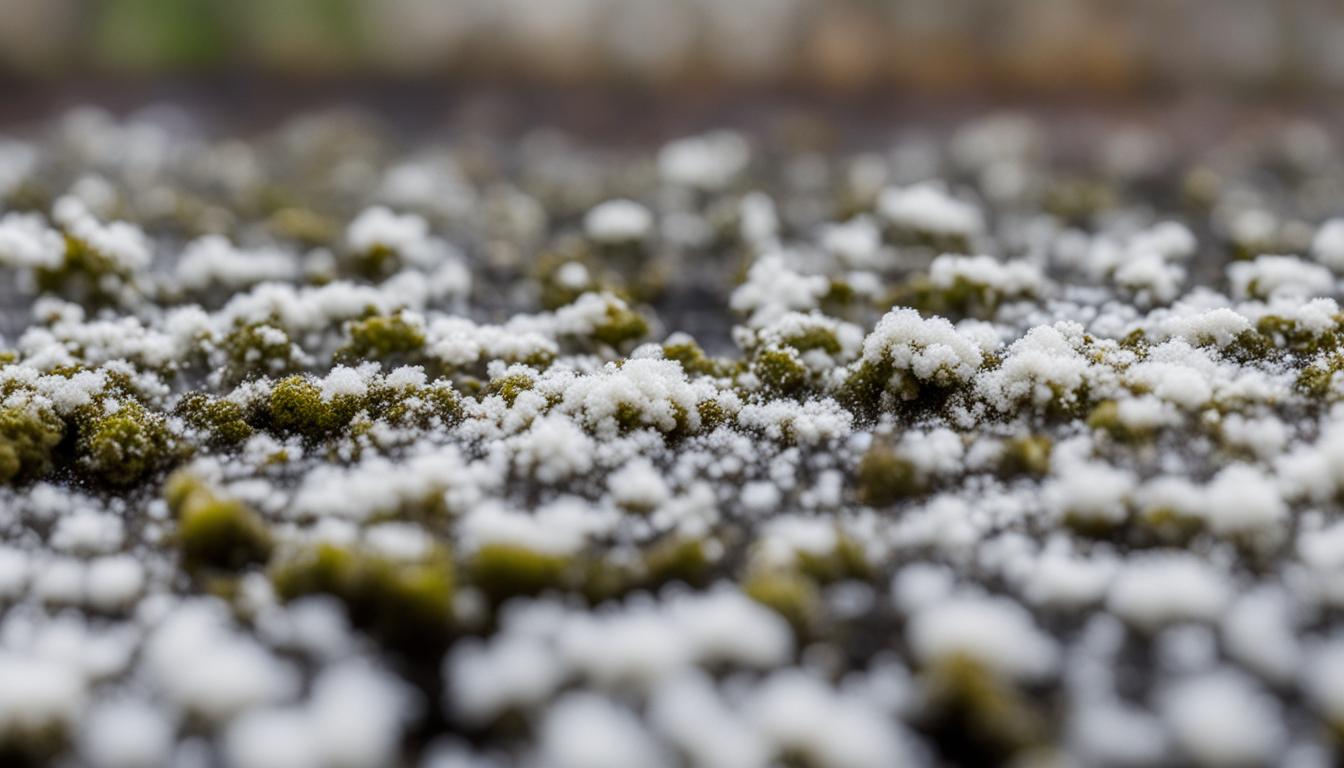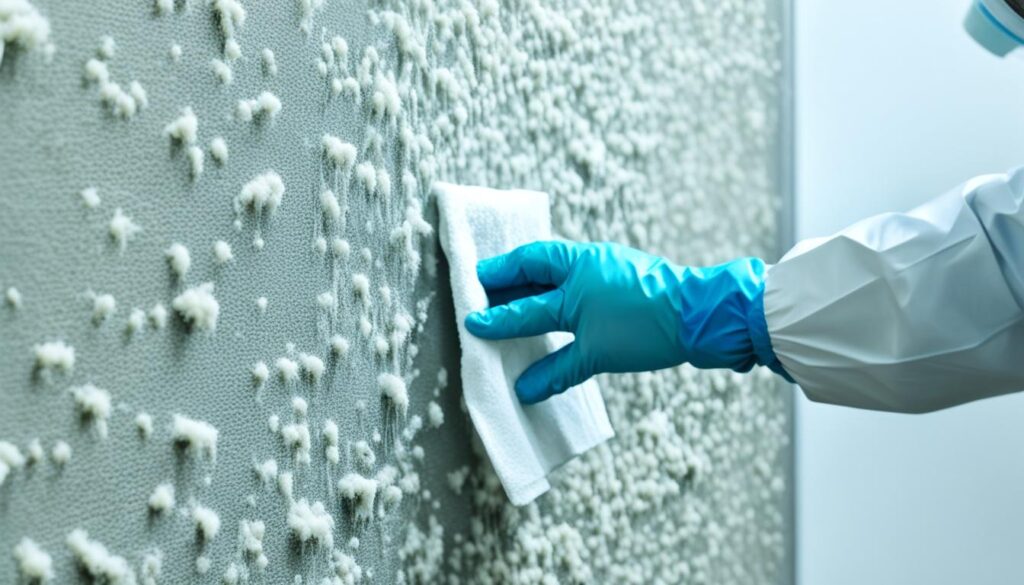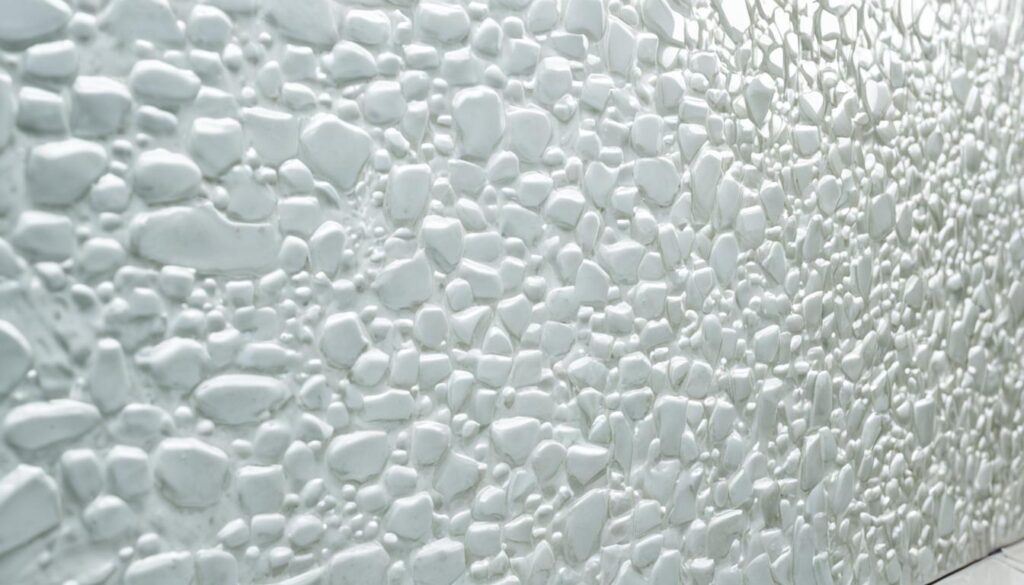
Best Way to Remove White Mold/Fungus From My Surfaces
Are white mold or fungus becoming a nuisance on your surfaces? Don’t worry, we’ve got you covered. In this article, we will explore the best methods for removing white mold or fungus from various surfaces, including walls, ceilings, furniture, and plants. Our experts will share their insights on effective removal techniques, prevention strategies, and provide useful DIY tips to help you tackle this issue head-on.
Key Takeaways:
- Effective removal techniques for white mold or fungus on different surfaces
- Prevention strategies to minimize the risk of future growth
- DIY tips and step-by-step instructions for safe and effective removal
- Understanding the development and identification of white mold and fungus
- Introduction to professional mold assessment and remediation services
Understanding White Mold and Fungus
Before diving into the removal process, it’s crucial to gain a comprehensive understanding of white mold and fungus. By familiarizing yourself with their characteristics, growth patterns, and identification, you’ll be better equipped to effectively address and prevent their presence.
White mold and white fungus are terms used interchangeably to describe a type of mold/fungus that appears white or light in color. They typically grow in damp or humid environments, making them common problems in areas with high moisture levels, such as bathrooms, basements, and kitchens.
Growth: White mold and fungus thrive in conditions with high humidity, poor ventilation, and organic materials to feed on. These fungi reproduce by releasing spores, which can spread through the air or attach to surfaces and cause new growth.
Identification: Recognizing the signs of white mold or fungus infestation is key to prompt action. Here are some common indicators:
- White or light-colored fuzzy patches on surfaces, such as walls, ceilings, or furniture
- A musty or earthy odor, particularly in enclosed spaces
- Discoloration or staining of materials
- Visible water damage, leaks, or condensation
- Health symptoms like respiratory issues, allergies, or skin irritation in individuals occupying the affected space
To help you better understand the growth and progression of white mold and fungus, refer to the table below:
| Growth Stage | Description |
|---|---|
| Initial Growth | White mold/fungus appears as small, fuzzy patches and may be mistaken for dust or debris. |
| Progression | The patches expand, covering larger areas, and develop a cotton-like texture. The musty odor becomes more pronounced. |
| Advanced Stage | The mold/fungus spreads rapidly, affecting multiple surfaces. It may release more spores, increasing the risk of health problems. |
Understanding the growth patterns and signs of white mold and fungus infestation is essential for effective identification and eradication. Armed with this knowledge, you can take appropriate measures to address their presence and prevent further growth in your living environment.
White Mold/Fungus Removal Methods
When it comes to removing white mold or fungus from different surfaces, it’s crucial to follow effective techniques and tips to ensure successful removal without causing damage or endangering your health. Our experts have curated a range of methods that you can use to eliminate white mold or fungus from various surfaces in your home or office. Read on to discover the best practices for white mold removal.
1. Identify the Affected Surfaces
Before you begin the removal process, it’s important to identify the surfaces affected by white mold or fungus. Inspect your walls, ceilings, furniture, carpets, or any other areas where you suspect mold growth. This will help you determine the extent of the infestation and focus your removal efforts accordingly.
2. Gather the Necessary Supplies
Before starting the removal process, gather the necessary supplies. This may include protective gear such as gloves, goggles, and a mask to ensure your safety. You will also need cleaning solutions, scrub brushes, rags, and a vacuum cleaner. Make sure to choose cleaning solutions specifically designed for mold removal.
3. Clean Non-Porous Surfaces
For non-porous surfaces like tiles, glass, or metal, effective cleaning is relatively straightforward. Start by scrubbing the affected area with a mold-specific cleaner or a mixture of water and detergent. Use a brush or sponge to remove visible mold. Once the surface is clean, rinse it thoroughly and dry it completely.
4. Treat Porous Surfaces
Porous surfaces like drywall, fabric, or wood require a different approach. Begin by removing any visible mold from the surface using a brush or vacuum cleaner with a HEPA filter. Next, treat the area with a mold-specific cleaner or a mixture of water and detergent. Allow the solution to penetrate the surface for the recommended amount of time. Finally, rinse the area with clean water and ensure it is thoroughly dried to prevent future mold growth.
5. Use Natural Remedies
In addition to commercial cleaning products, you can also use natural remedies to remove white mold or fungus. Vinegar and hydrogen peroxide are two common household items that can effectively kill mold. Mix equal parts vinegar or hydrogen peroxide with water and apply the solution to the affected surface. Allow it to sit for a few minutes before scrubbing and rinsing the area.
6. Dispose of Contaminated Materials
If any materials cannot be effectively cleaned or treated, it is best to dispose of them to prevent further mold growth. This may include heavily contaminated carpets, drywall, or upholstery. Seal the materials in plastic bags and dispose of them following local regulations for hazardous waste disposal.
By following these removal methods and tips, you can effectively eliminate white mold or fungus from different surfaces in your environment. Remember to take the necessary precautions to protect yourself during the removal process and consider seeking professional assistance if the infestation is extensive.

Stay tuned for the next section, where we will provide you with valuable DIY tips for white mold or fungus removal, allowing you to confidently address the issue on your own.
DIY White Mold/Fungus Removal Tips
If you prefer to tackle white mold or fungus removal on your own, you’ve come to the right place. Our experts have compiled step-by-step DIY tips and techniques to help you safely and effectively remove white mold or fungus from different surfaces in your home.
1. Wear Protective Gear
Before you start the removal process, it’s crucial to protect yourself. Put on gloves, a face mask, and safety goggles to prevent direct contact with the mold or fungus spores and minimize the risk of respiratory issues or skin irritation.
2. Ventilate the Area
Open windows and use fans to ensure proper ventilation in the affected area. This will help dissipate the mold or fungus spores and reduce their concentration in the air as you work.
3. Identify the Source
Locate the source of moisture that is causing the mold or fungus growth and address it. This could be a leaky pipe, a damaged roof, or high humidity levels. By eliminating the source of moisture, you can prevent future mold or fungus issues.
4. Clean Surfaces
Using a detergent solution and a scrub brush, clean the affected surfaces thoroughly. Be sure to remove any visible mold or fungus growth and wipe down the area to remove spores. Rinse the surfaces with clean water and dry them completely.
5. Use White Vinegar
White vinegar is a natural and effective cleaning agent that can help kill mold or fungus spores. Mix equal parts white vinegar and water in a spray bottle and apply it to the affected surfaces. Let it sit for a few minutes before scrubbing and rinsing as before.
6. Try Hydrogen Peroxide
Hydrogen peroxide is another option for DIY mold or fungus removal. Use a 3% solution of hydrogen peroxide and spray it directly onto the affected surfaces. Allow it to sit for 10-15 minutes before scrubbing and rinsing.
7. Prevent Future Growth
After completing the removal process, take preventive measures to avoid future mold or fungus growth. Keep your home well-ventilated, fix any moisture issues promptly, and monitor humidity levels. Regularly clean and inspect areas prone to mold or fungus, such as bathrooms, basements, and kitchens.
Remember, while DIY removal methods can be effective for small, isolated areas of mold or fungus, severe infestations or extensive damage may require professional assistance. If you’re unsure or uncomfortable with handling the situation yourself, it’s best to consult a professional mold remediation service.
| DIY White Mold/Fungus Removal Tips |
|---|
| Wear protective gear (gloves, face mask, goggles) |
| Ventilate the area with open windows and fans |
| Identify and address the source of moisture |
| Clean surfaces with detergent solution |
| Use white vinegar as a natural cleaning agent |
| Try hydrogen peroxide for effective removal |
| Prevent future growth through proper ventilation and maintenance |
By following these DIY white mold or fungus removal tips, you can maintain a healthy and mold-free environment in your home. Stay proactive in preventing moisture issues and addressing any signs of mold or fungus promptly for a clean and safe living space.
Prevention Strategies for White Mold/Fungus
Prevention is crucial when it comes to dealing with white mold or fungus. By implementing effective strategies and preventive measures, you can minimize the risk of future growth and ensure a healthy environment. In this section, we will explore various prevention strategies and highlight the importance of mold assessment in identifying potential problem areas.
Regular Inspection and Mold Assessment
To effectively prevent white mold or fungus, it is essential to conduct regular inspections and mold assessments. This process helps identify any existing mold or potential areas of concern. By proactively addressing these issues, you can nip the problem in the bud before it escalates.
Address Moisture and Humidity Levels
Moisture and high humidity are primary contributors to white mold or fungus growth. To prevent these conditions, ensure proper ventilation in your home and promptly fix any leaks or water-related issues. Regularly monitor and maintain optimal humidity levels, ideally below 60%, to discourage mold infestations.
Adequate Ventilation
Proper airflow and ventilation promote a dry environment that discourages mold growth. Ensure that your home has adequate ventilation in areas such as bathrooms, kitchens, and basements. Utilize exhaust fans and open windows when cooking, showering, or doing laundry to minimize moisture accumulation.
Maintain Clean and Dry Surfaces
Regular cleaning and drying of surfaces play a significant role in mold prevention. Be diligent in cleaning and drying areas prone to moisture, such as bathrooms and kitchens. Remove any visible mold or mildew promptly using appropriate cleaning agents and techniques.
Proper Insulation and Waterproofing
Well-insulated and waterproofed homes prevent moisture intrusion, reducing the chances of mold development. Insulate walls, floors, and ceilings properly to minimize condensation and keep moisture levels in check. Ensure proper sealing and waterproofing in areas susceptible to water exposure, such as basements and crawl spaces.
Maintain Proper Indoor Air Quality
Good indoor air quality helps prevent mold growth and promotes a healthy living environment. Keep indoor humidity levels low, maintain clean HVAC systems, and regularly replace filters. Additionally, consider using air purifiers or dehumidifiers to control moisture and improve air quality.
Education and Awareness
Stay informed about common signs of mold growth and prevention techniques. Educate yourself and household members on proper maintenance practices, such as promptly reporting any water leaks or excess moisture. By being aware and proactive, you can swiftly address potential mold issues before they become major problems.
“Preventing white mold or fungus growth requires a comprehensive approach that includes regular assessments, moisture control, proper ventilation, and education. By implementing these strategies, you can create a mold-free environment and promote the well-being of your home and family.”
To summarize:
- Regularly inspect and assess your home for mold
- Address moisture and humidity levels
- Promote adequate ventilation
- Maintain clean and dry surfaces
- Properly insulate and waterproof your home
- Maintain proper indoor air quality
- Stay educated and aware of mold prevention techniques
By following these prevention strategies, you can effectively combat white mold or fungus and create a healthy living space.
White Mold/Fungus on Specific Surfaces
White mold or fungus can appear on various surfaces, such as walls, ceilings, furniture, or even plants. It is important to address the issue promptly to prevent further spread and damage. In this section, we will provide surface-specific tips and techniques to help you remove white mold or fungus from different types of surfaces effectively.
Removing White Mold/Fungus from Walls and Ceilings
If you notice white mold or fungus on your walls or ceilings, it’s crucial to take immediate action to prevent it from spreading. Here are some surface-specific tips for removing white mold or fungus from walls and ceilings:
- Wear protective gloves, goggles, and a mask to avoid direct contact with the mold.
- Prepare a solution of water and vinegar or hydrogen peroxide.
- Using a sponge or cloth, gently scrub the affected area with the solution.
- If the mold persists, consider using a specialized mold removal product.
- After cleaning, ensure proper ventilation to prevent moisture buildup.
Eliminating White Mold/Fungus from Furniture
White mold or fungus on furniture can be a common problem, especially in humid environments. To remove white mold or fungus from your furniture, follow these surface-specific tips:
- Take the furniture outdoors to prevent the spread of mold spores inside your home.
- Vacuum the surface of the furniture to remove any loose spores or debris.
- Wipe the furniture with a mixture of water and mild detergent.
- Rinse the furniture with clean water and pat dry.
- Consider using a natural antifungal spray to prevent future mold growth.
Dealing with White Mold/Fungus on Plants
If you notice white mold or fungus on your plants, it’s important to act quickly to protect their health. Here are some surface-specific tips for removing white mold or fungus from plants:
- Isolate the affected plant to prevent the spread of mold to other plants.
- Remove any visibly affected parts of the plant, including leaves, stems, or flowers.
- Apply a natural antifungal solution or a neem oil spray to the remaining healthy parts of the plant.
- Ensure proper air circulation and sunlight to prevent mold growth.
- Regularly monitor your plants for any signs of recurring white mold or fungus.
By following these surface-specific tips and techniques, you can effectively remove white mold or fungus from different surfaces and safeguard the health of your home and belongings.

Professional Mold Assessment and Remediation Services
Sometimes, a white mold or fungus infestation can be severe or difficult to handle on your own. That’s when you need the expertise of trusted professionals to assess the situation and provide effective remediation solutions. Introducing Fix Mold Miami, Florida’s Highest Rated In Mold Assessments, Prevention, and Remediation service provider.
At Fix Mold Miami, we understand the importance of a thorough and accurate mold assessment. Our team of certified professionals is equipped with advanced tools and years of experience to identify and analyze mold issues in your home or commercial space. From initial inspection to comprehensive testing, we leave no stone unturned when it comes to identifying mold presence and assessing its severity.
Once the mold assessment is complete, our skilled technicians employ industry-leading techniques and state-of-the-art equipment to remove mold and restore the affected areas. We follow a meticulous process that ensures efficient and lasting mold remediation without causing further damage to your property.
Our commitment to customer satisfaction goes beyond mold removal. We believe in preventing mold issues from recurring. Our experts will provide you with valuable insights and recommendations to prevent future mold infestations. By addressing the underlying causes and implementing preventive measures, we aim to create a mold-free environment for you and your family.
“At Fix Mold Miami, our priority is your safety and well-being. Our team is dedicated to delivering professional mold assessment and remediation services that exceed your expectations. We take every mold issue seriously and treat each customer’s property with the utmost care and respect.”
Why Choose Fix Mold Miami?
- Experienced and certified mold assessment professionals
- State-of-the-art equipment for accurate mold detection
- Meticulous mold remediation process
- Comprehensive preventive strategies to minimize future mold growth
- Exceptional customer service and support
Don’t let mold issues compromise your health and the integrity of your property. Contact Fix Mold Miami today at 305-465-6653 for a thorough mold assessment and reliable remediation services.
Conclusion
In conclusion, when it comes to dealing with white mold or fungus on your surfaces, it is crucial to have the right knowledge, techniques, and preventive measures in place. By following the expert tips and techniques outlined in this article, you can effectively remove white mold or fungus and greatly reduce the risk of future infestations.
Remember, prevention is key. Regularly inspecting your home for signs of moisture, improving ventilation, and keeping humidity levels in check can go a long way in preventing the growth of white mold or fungus. Additionally, addressing any water leaks or condensation issues promptly can help minimize the risk of mold or fungus development.
However, in severe cases or if the problem exceeds your capabilities, it is always wise to seek professional help. Reputable mold assessment and remediation services like Fix Mold Miami have the expertise and tools to accurately assess the extent of the infestation and provide effective remediation solutions.
By taking proactive measures, staying informed, and employing the right techniques, you can successfully combat white mold or fungus, ensuring a clean and healthy environment for you and your loved ones.




